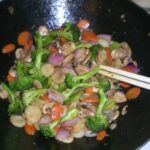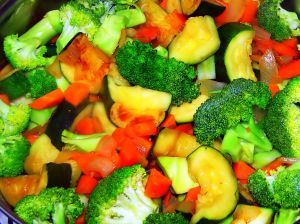I’ve been eating Chinese food since infancy (my mother was raised in Shanghai) and cooking it since my college days. So, when it recently became time to replace my trusty wok, you’d think I’d be fairly knowledgeable about my options.
However, I soon found that with today’s woks- as with just about everything worth having! – the number of choices available and the many decisions a buyer needs to make can be so overwhelming that even an experienced cook can end up, well, between a wok and a hard place. After some careful research, I’ve compiled an overview of key considerations that should be useful for anyone else who is thinking of replacing or upgrading a wok, or investing in one for the first time.
With current wok prices ranging from under $30 to well over $200, you’ll probably want to begin your wok quest by targeting a price range. Then, take a closer look at some of the features that distinguish one type of wok from another and think about the advantages and disadvantages of each with regard to your particular situation. The final step is probably the most important – to consider how you tend to use your wok. This will help you narrow down the best choices within your price range and can be the deciding factor with regard to whether you need a particular size, shape, or material, as well as accessories such as a lid or supporting ring.
PRICE — HOW MUCH WOK CAN YOU BUY?
Even if you can’t spend more than $50, you still have a lot of choices. Carbon steel woks, the most popular type, can be found online for as little as $19.99. They are even available as starter kits, which include lids, tools, and other accessories. However, the cheaper ones can have problems such as hot spots or a tendency toward uneven shapes, so you would probably be best off choosing one in the $40 to $50 range. Woks made from cast iron are available in a wide range of prices, but in this case the more expensive ones, while sturdy, may be too heavy for some cooks. So, although the more affordable cast-iron rocks may be a bit fragile, I’d suggest one of these for the most budget-conscious cook. Both carbon steel and cast-iron woks must be cleaned and seasoned with oil before use. Looking at the high-end woks, you’ll find greater durability, versatility, and ease of care as well as a lot more eye appeal – a wok made of gleaming stainless-steel, dramatic black anodized aluminum, or colorful enameled cast-iron is certainly more attractive than one made from old-fashioned, time-honored carbon steel. If these things are important to you and you are willing to pay handsomely for them, by all means treat yourself.
FEATURES – WHAT YOU REALLY NEED (AND WHAT YOU DON’T)
It’s hard for me to understand why anyone would want a wok that doesn’t come with a cover, but it appears that nowadays, many people do. While we may be jumping ahead to step three a bit here, I’d say that unless you plan to use the wok exclusively for stir-frying and deep-frying, you definitely want to have a cover for it. (Note that many stir-fry recipes call for liquid to be added and the wok covered briefly near the end of the cooking time.) If you’re going with one of the authentic Chinese round-bottom shapes, you will also need a supporting ring to keep it stable on your stovetop. Other items that are found in wok starter kits (cooking chopsticks, steel racks for deep-frying, wooden spatulas, recipe booklets) are not essential. Unless you are buying a cheap wok with a non-stick coating (which requires wooden tools so as not to scratch the surface), you are better off buying your stir-frying tools separately or using tools you already have.
Speaking of non-stick coating, avoid it. The reason I’m replacing my wok is that its non-stick coating has become scratched and is peeling off in places. This is typical of the cheaper non-stick woks, which are made with coatings of Teflon or similar materials, which are neither durable or well suited to the high-heat cooking the wok was designed for. If you absolutely must have a non-stick wok, spend a bit more and buy a Calphalon or Circulon wok, which are made of anodized aluminum, or a cast-iron wok covered with porcelain enamel, such as those made by Iron Chef or even LeCreuset.
The classic Chinese wok has small looped handles on each side. Many American-made woks have a long handle on one side. There are also hybrid versions that combine a long handle with a smaller curved handle on the opposite side. Whatever handle style you prefer, it is a good idea to look for one that doesn’t conduct heat! The lower-end woks often have bare metal handles; if so, you’ll need to keep a towel handy to wrap around them — the last thing you want is to burn yourself trying to keep your wok centered on the burner.
WOK-ING AND ROLLING – HOW YOU USE YOUR WOK
Are you wok-ing on a gas stove or an electric one? While all sorts of adapters are available to facilitate the use of woks on electric stoves, they can be very expensive and may not be very effective. Here’s how to determine the best wok for your stove:
— With a gas stove, you can use a traditional round-bottomed wok and get the full benefits of its efficient, heat-conserving design. You’ll need to place it directly over the burner and support it on a gas ring.
— With a coil-type electric stove, you’ll need a flat-bottomed wok, which were hard to find when I bought my old wok but are now available in as wide a variety of materials as the traditional woks.
— If you have an electric stove that uses the induction method, you’ll find your wok choices limited. Some flat-bottom woks can be used on induction stove-tops but you are probably better off choosing a separate electric wok. Many Chinese cookbooks advise you to steer clear of these, and indeed, those first marketed in the U.S. were not of very high quality, but advancements in materials and heating efficiency have produced many highly-rated electric woks that are as effective as traditional woks and offer you more precise temperature control.
What do you cook in your wok? Do you simply stir-fry in it, or do you explore other Chinese cooking techniques such as steaming, deep-frying, or braising? The more varied the uses you plan for your wok, the larger and deeper it should be, and the more consideration you should give to a higher-quality material. If you do a fair amount of steaming, you’ll want to choose one with a high domed lid to accommodate a bamboo steamer with several layers.
How many people are you wok-ing for? The most common size of wok is 14″ in diameter and will allow you to stir-fry enough food for three or four people. If you only cook for one or two people, consider a smaller wok (12″ or 10″) because it will be more affordable and cook more efficiently. If you have a larger family or like to entertain, you can certainly find a larger wok – www.cooking.com offers some as large as 26″ in diameter – but most are the simple, basic carbon steel variety.
In the final analysis, only you can determine what will be the right wok for your needs. But I think you’ll find that taking this approach to review the possibilities will point you in the right direction.
As for me, I’ve decided on a 12″ round-bottom non-stick wok with a heat-resistant handle. Now, all I have to do is find one I can afford!
(Sources for information in this article included Martin Yan’s Asia, The People’s Republic of China Cookbook, Wikipedia, and www.cooking.com as well as my own experiences)





